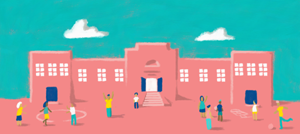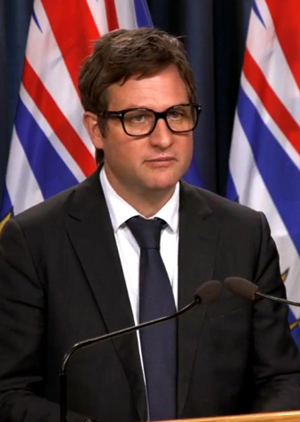
Wednesday August 26, 2020 ~ VICTORIA, BC
by Mary P Brooke, B.Sc, editor | Island Social Trends
The Horgan NDP government is determined that public education in BC will not fall on the sword of the COVID-19 pandemic.
As the COVID public health emergency continues, the long-awaited clarification of 2020-2021 back to school plans for K-12 education in BC was unveiled today by Education Minister Rob Fleming.
Back to school plans are now posted for all 60 school districts, so parents and families can prepare to support their children for a safe return to the classroom.
Families should visit their school district website to view their local school’s plans. Here are the website links for the four south Vancouver Island school districts:
- SD61 – Greater Victoria (50 schools: 27 elementary, 12 middle, 7 secondary, 4 alternative) | Superintendent Shelley Green
- SD62 – Sooke / west shore (26 schools: 18 elementary, 4 middle, 3 secondary, 1 alternative) | Superintendent Scott Stinson
- SD63 – Saanich (22 schools: 9 elementary, 4 middle, 6 secondary, 3 alternative & community programs) | Superintendent Dave Eberwein
- SD79 – Cowichan Valley (22 schools: 17 elementary, 5 secondary) | Superintendent Robyn Gray
Forward-motion for in-class learning:
“There is no better place than in-class learning. With these plans now in place, parents can feel confident about sending their children back to school and assured that strict health and safety measures are in place to protect students and staff,” said Minister Fleming.
Parents will find detailed back to school plans on their district website. In addition to health and safety measures, the plans include:
- * how learning groups will be organized;
- * when masks are required;
- * daily schedules for classes, lunch and recess;
- * daily health assessment requirements;
- * pick-up and drop off times;
- * protocols for common areas;
- * hand washing directions; and
- * orientation information.
Flexibility and remote options:
“I know that some families will continue to have medical or health concerns, and my expectation is that school districts will be flexible and work with families to provide remote options that keep children connected to their school community,” Fleming said today.
The education minister has directed school districts to contact all families in their school communities to share their safety plans and to confirm if they are planning for their child to attend school classes in September, or if they need alternative learning options. As part of the ministry’s July 29 guidelines for planning, many districts have already begun engaging with parents to determine their needs.
The Ministry of Education has also given school districts the flexibility and certainty to find options that work for families. This includes the authority for all school boards to offer remote options to students within their districts, as well as the tools they need to increase their existing programs to meet demand.
While schools may look different in different communities, all school districts are also required to follow operational guidelines developed by a provincial steering committee made up of parents, teachers, support workers, Indigenous rightsholders, school leaders and trustees. School districts were also required to consult local First Nations on the development of their plans.
School districts at the core of delivery:
“Since the beginning of the pandemic, boards of education throughout B.C. have worked hard to make sure local community needs are met within the health and safety framework provided by the provincial health officer,” said Stephanie Higginson, president, British Columbia School Trustees Association. “Districts will continue to work with parents and families, as they have always done, to ensure children returning to school in September are able to do so safely.”
Each school district plan follows the same strict provincial health and safety measures co-developed with the provincial health officer, the BC Centre for Disease Control and the Ministry of Education. School districts are adapting their schedules and learning groups to fit within those measures based on student population and local consultation with education partners, parents and Indigenous rightsholders.
Elementary and middle schools full time:
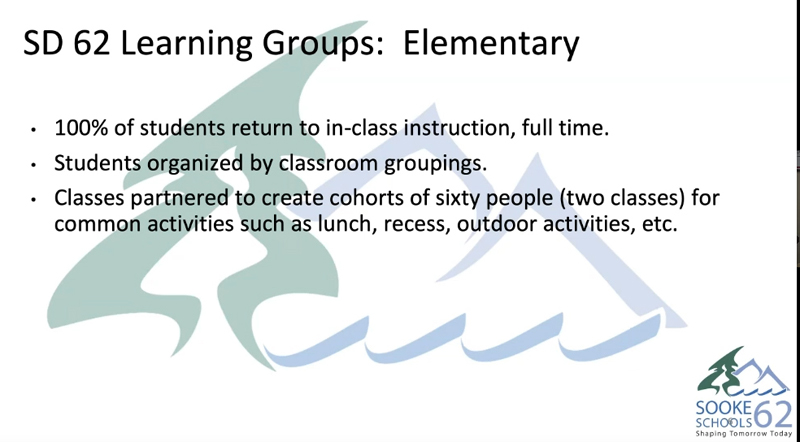
“Every day, school districts are prepared to welcome all students to elementary and middle schools,” the ministry says. Students in Kindergarten to Grade 8 are expected to attend in-class instruction full time. Learning groups (cohorts) will be up to 120 people (students, teachers, support staff, and bus drivers).
Secondary schools adapting their semesters:
For secondary schools, timetable scheduling has been modified to adhere to the health and safety requirements and ensure that all students can attend most days, with much of their instruction occurring in-class, the ministry said today. The majority of school districts in BC (68%) are moving to a quarterly semester system in some or all of their secondary schools.
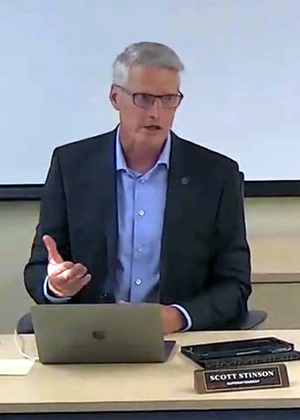
In SD62’s three high schools in the fast-growing west shore (Belmont Secondary School in Langford, Royal Bay Secondary in Colwood, and EMCS in Sooke), student course selection (much of which would have been chosen pre-COVID) has been maintained.
Students in Grades 9 to 12 in SD62 will attend half-days under a one-eighth system, where eight classes will be taken in sequence –i.e. consecutively through the school year, each course for five weeks. Attendance in-class will be for half a day, with homework to be done in the other half of the day. It’s robust, but has been proven (in summer schooling experience) to be effective, said SD62 Superintendent Scott Stinson at the SD62 Education Policy Committee meeting on August 25.
Focus on mental health:
Districts will support mental health and wellness, it was stated by the Ministry today.
Part of that is ensuring that vulnerable students and those who require additional support in school — including students with disabilities and diverse abilities, and children and youth in care — are prioritized for full-time, in-class learning and services without delays.
Trauma-informed approaches will be utilized in various ways at the school district level in response to recognizing the impact of social distancing, being remote from friends and classmates during the pandemic, and the overall heightened stress levels of constant vigilance for just getting through a regular day under pandemic conditions.
More teacher-counsellors and additional partner-supports:

There will also be an increase of teacher-counsellor staffing positions, to support demand, it was revealed by the ministry today. That will be complemented by “looking for other kinds of partners” in the delivery of mental health and wellness services as part of meeting “certain high expectations” for mental and social well being.
Apparently a survey to “identify needs” in the area of counselling in BC schools had already been done pre-COVID. Now COVID has “created a new need”. The Ministry says it is “working actively with schools” and that schools will “see some additianl resources” toward mental health supports.
The $242 million in additional funds to BC from the federal government today ($2 billion in total to the provinces and territories — announced by Prime Minister Justin Trudeau today) will be helpful to all areas of enhanced supports to education in 2020-2021. Yes, some of that will be applied to the mental health aspects of school community care, it was confirmed today by Ministry officials.
Health and safety measures:

The health and safety measures for all school districts to follow include:
- masks will be required for staff, middle and secondary students in high-traffic areas, such as buses, and in common areas, such as hallways, or anytime outside of their learning group whenever physical distancing cannot be maintained (exceptions will be made for students who cannot wear masks for medical reasons);
- even when wearing a mask, staff and students will still be required to maintain physical distance from people outside of their learning group;
- increased cleaning of high-contact surfaces, such as doorknobs, keyboards, desks and chairs;
- increased hand hygiene with all students, staff and visitors being required to clean their hands before boarding school buses and entering school buildings, before and after eating, using the washroom and using playground equipment;
- school districts may also install transparent barriers for people who have more contact with others, such as front-desk staff, bus drivers or food services staff, where appropriate; and
- staff and students (or their parents/guardians) must also assess themselves daily for illness, including symptoms of COVID-19. If any student or staff member has even mild symptoms, arrangements will be made for that person to return home.
BC’s efforts to ‘get it right’:
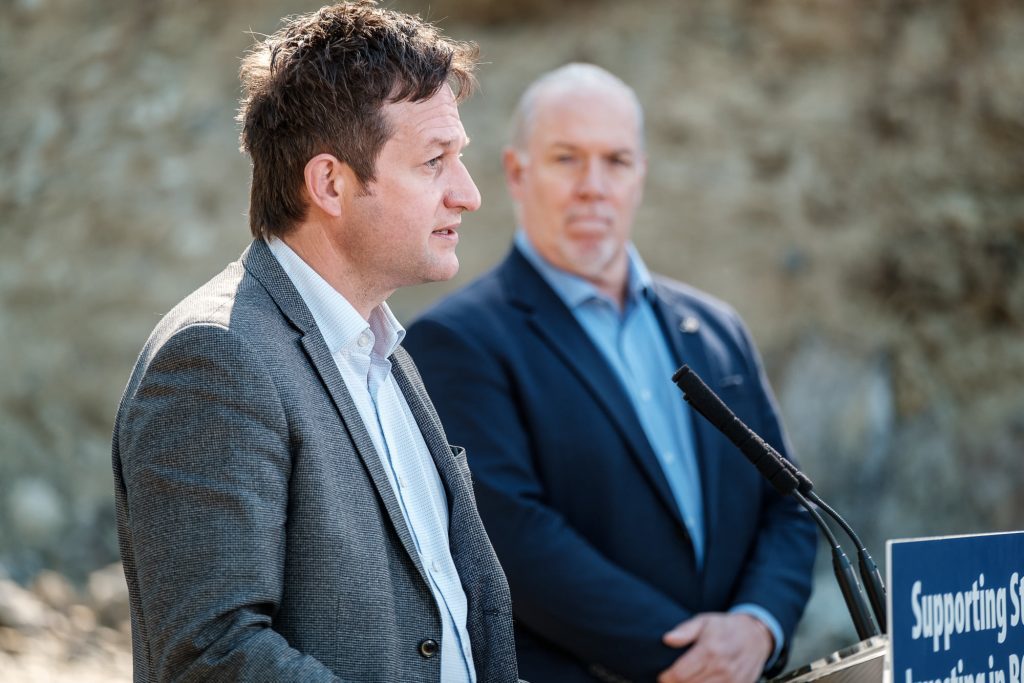
Certainly with the overall core belief of Premier John Horgan that public education is the biggest game-changer for a progressive society, the BC Ministry of Education has laboured hard all summer to produce its plans for a safe school restart for 2020-2021.
The premier, Minister Fleming, and stakeholders throughout the education system in BC express pride in their accomplishment at having studied a safe return to school in June of this year. That month about one-third of students came into the schools for at least some portion of the instructional period. Things like how physical distancing and staggered scheduling might work were observed.
A working group of stakeholders met frequently throughout this summer. The guidelines for school districts to work with were released on July 29 by Minister Fleming, and today August 26 all public school districts had their plans posted on district websites. Independent school plans are being reviewed by the Ministry this week; those plans will be posted on school websites early next week.
Providing remote learning options:
The Province listened to concerns from teachers, students and parents in recent weeks. The Ministry of Education is providing a range of supports for remote learning for school districts, teachers and parents.
School districts
- Extended the authority to all school boards to offer online programs to students within their districts.
- Gave districts the ability to expand their local distributed learning programs to include additional grades and services to students and district schools to meet local needs.
- Provided a provincial learning management system (MOODLE) for districts to support online learning.
- Upgraded internet access to all schools in the province through the K-12 Next Generation Network.
- Provided a provincial license for Zoom for all schools as a secure platform for real-time videoconferencing.
Parents and caregivers
- Provided $3 million through the Safe Return to Schools Grant to loan technology to students (such as tablets or laptops) to support their educational program.
- Enhanced the Keep Learning Website with additional resources for parents. This is a central place where families can find ideas for everyday educational activities, links to free learning resources, as well as how to help children learn and how to ensure their well-being while they are at home: https://www.openschool.bc.ca/keeplearning/
- Worked with telecom and internet service providers to ensure families and school districts were provided with information about access to internet assistance and connectivity programs (such as Internet for Good).
Teachers
- Created an online repository of over 2,000 curated learning resources for use by teachers and staff to support the new curriculum, suitable for use online or in class.
- Provided funding for teachers to develop additional resources for this fall, through a partnership with the not-for-profit organization FocusED.
- Worked with the Western Canadian Learning Network, a school district consortium, to provide a full set of course resources for grades 4-12 for teachers using MOODLE.
- Funded a provincial site license for Zoom to ensure a common, consistent platform to communicate and share lessons with their students.
- Provided a new self-paced course with strategies for incorporating remote and in-person learning in the classroom.
- Launched a webinar series hosted by experts to support teachers throughout the province about changing their teaching or learning environments. The first webinar, Building Compassionate Communities in the Classroom, is scheduled for Sept. 9.
Homeschooling option:
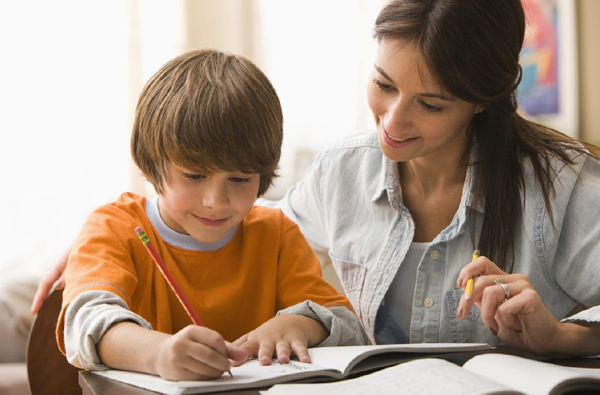
During COVID, there has been increased interest in the homeschooling option, and today Minister Fleming articulated the continued availability of that program.
During a regular school year, districts also accommodate students that cannot attend in-class instruction through the long-standing B.C. Homebound Program. This enables students to continue their education program if they are absent from school for periods during the school year because of medical reasons, such as injury, illness, surgery, pregnancy, or mental health reasons.
Five-stage approach guided by public health:

The Ministry of Education has developed a five-stage approach to operate schools, depending on risk of transmission and guidance from the provincial health officer. This helps school districts know what to expect if there is a significant change to school operations required as part of B.C.’s response to the COVID-19 pandemic.
To support and ensure the health and safety of students and staff during this pandemic, a one-time investment of $45.6 million as part of B.C.’s COVID-19 Action Plan will support school districts and independent schools for the start of the school year. This funding will support the purchase of up to 1.5 million masks, enough for every public-school staff member and student to have at least two masks.
Canadian Shield, a manufacturer of personal protective equipment products in Ontario, recently announced it is donating an additional 54,500 face shields for K-12 schools in B.C., adding to the inventory of personal protective equipment that will be available for students and staff.
===== Links:
For more info on back-to-school plans, learning groups and health and safety guidelines visit: https://www2.gov.bc.ca/gov/content/education-training/k-12/covid-19-return-to-school
Details of the SD62 Education Policy Committee Meeting (August 25, 2020).




